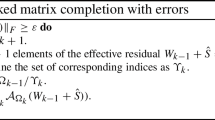Abstract
Consider the problem of determining whether or not a partial dissimilarity matrix can be completed to a Euclidean distance matrix. The dimension of the distance matrix may be restricted and the known dissimilarities may be permitted to vary subject to bound constraints. This problem can be formulated as an optimization problem for which the global minimum is zero if and only if completion is possible. The optimization problem is derived in a very natural way from an embedding theorem in classical distance geometry and from the classical approach to multidimensional scaling. It belongs to a general family of problems studied by Trosset (Technical Report 97-3, Department of Computational & Applied Mathematics—MS 134, Rice University, Houston, TX 77005-1892, 1997) and can be formulated as a nonlinear programming problem with simple bound constraints. Thus, this approach provides a constructive technique for obtaining approximate solutions to a general class of distance matrix completion problems.
Similar content being viewed by others
References
A. Alfakih, A. Khandani, and H. Wolkowicz, “An interior-point method for approximate distance matrix completions,” CORR, University of Waterloo, Technical Report 97-9, 1997.
M. Bakonyi and C.R. Johnson, “The Euclidean distance matrix completion problem,” SIAM Journal on Matrix Analysis and Applications, vol. 16, pp. 646-654, 1995.
W. Braun, “Distance geometry and related methods for protein structure determination from NMR data,” Quarterly Reviews of Biophysics, vol. 19, pp. 115-157, 1987.
A.T. Brünger and M. Nilges, “Computational challenges for macromolecular structure determination by Xray crystallography and solution NMR spectroscopy,” Quarterly Reviews of Biophysics, vol. 26, pp. 49-125, 1993.
R.H. Byrd, P. Lu, J. Nocedal, and C. Zhu, “A limited memory algorithm for bound constrained optimization,” SIAM Journal on Scientific Computing, vol. 16, pp. 1190-1208, 1995.
G.M. Crippen and T.F. Havel, Distance Geometry and Molecular Conformation, John Wiley & Sons: New York, 1988.
D.M. Gay, “Algorithm 611. Subroutines for unconstrained minimization using a model/trust-region approach,” ACM Transactions on Mathematical Software, vol. 9, pp. 503-524, 1983.
D.M. Gay, “Atrust region approach to linearly constrained optimization,” in Numerical Analysis, F.A. Lootsma (Ed.), Springer: Berlin, 1984, pp. 171-189. Proceedings, Dundee, 1983.
W. Glunt, T.L. Hayden, and M. Raydan, “Molecular conformations from distance matrices,” Journal of Computational Chemistry, vol. 14, pp. 114-120, 1993.
R. Grone, C.R. Johnson, E.M. Sá, and H. Wolkowicz, “Positive definite completions of partial Hermitian matrices,” Linear Algebra and Its Applications, vol. 58, pp. 109-124, 1984.
T.F. Havel, “An evaluation of computational strategies for use in the determination of protein structure from distance constraints obtained by nuclear magnetic resonance,” Progress in Biophysics and Molecular Biology, vol. 56, pp. 43-78, 1991.
T.F. Havel and K. Wüthrich, “An evaluation of the combined use of nuclear magnetic resonance and distance geometry for the determination of protein conformations in solution,” Journal of Molecular Biology, vol. 182, pp. 281-294, 1985.
C.R. Johnson, “Matrix completion problems: A survey,” in Matrix Theory and Applications, C.R. Johnson (Ed.), American Mathematical Society: Providence, RI, 1990, pp. 171-198. Proceedings of Symposia in Applied Mathematics, Vol. 40.
C.R. Johnson, C. Jones, and B. Kroschel, “The distance matrix completion problem: Cycle completability,” Linear and Multilinear Algebra, vol. 39, pp. 195-207, 1995.
C. Johnson, B. Kroschel, and H. Wolkowicz, “An interior-point method for approximate positive semidefinite completions,” Computational Optimization and Applications, vol. 9, pp. 175-190, 1998.
C.R. Johnson and P. Tarazaga, “Connections between the real positive semidefinite and distance matrix completion problems,” Linear Algebra and Its Applications, vol. 223/224, pp. 375-391, 1995.
I.D. Kuntz, J.F. Thomason, and C.M. Oshiro, “Distance geometry,” in Nuclear Magnetic Resonance, Part B: Structure and Mechanism, N.J. Oppenheimer and T.L. James (Eds.), Academic Press: New York, 1989, pp. 159-204. Methods in Enzymology, Vol. 177.
K.V. Mardia, J.T. Kent, and J.M. Bibby, Multivariate Analysis, Academic Press: Orlando, 1979.
J.J. Moré and Z. Wu, “∈-Optimal solutions to distance geometry problems via global continuation,” Mathematics & Computer Science Division, Argonne National Laboratory, Argonne, IL 60439-4844, Preprint MCSP520-0595, May 1995.
J.J. Moré and Z. Wu, “Distance geometry optimization for protein structures,” Mathematics & Computer Science Division, Argonne National Laboratory, Argonne, IL 60439-4844, Preprint ANL/MCS-P628-1296, Dec. 1996.
T.A. Parks, “Reducible nonlinear programming problems,” Technical Report 85-8, Department of Mathematical Sciences, Rice University, Houston, TX, 1985. Author's Ph.D. Thesis.
Statistical Sciences, S-PLUS for Windows Reference Manual, Version 3.1, Vol. 2, Statistical Sciences: Seattle, 1993.
M.W. Trosset, “Numerical algorithms for multidimensional scaling,” in Classification and Knowledge Organization, R. Klar and P. Opitz (Eds.), Springer: Berlin, 1997, pp. 80-92. Proceedings of the 20th annual conference of the Gesellschaft für Klassifikation e.V., held March 6-8, 1996, in Freiburg, Germany.
M.W. Trosset, “Computing distances between convex sets and subsets of the positive semidefinite matrices,” Technical Report 97-3, Department of Computational & Applied Mathematics-MS 134, Rice University, Houston, TX 77005-1892, 1997.
M.W. Trosset, “Applications of multidimensional scaling to molecular conformation,” Computing Science and Statistics, vol. 29, pp. 148-152, 1998.
M.W. Trosset, “A new formulation of the nonmetric STRAIN problem in multidimensional scaling,” Journal of Classification, vol. 15, pp. 15-35, 1998.
M.W. Trosset and G.N. Phillips, “Deriving interatomic distance bounds from chemical structure,” in Statistics in Molecular Biology and Genetics, F. Seillier-Moiseiwitsch (Ed.), IMS Lecture Notes-Monograph Series, vol. 33, pp. 276-287, 1999.
C. Zhu, R.H. Byrd, P. Lu, and J. Nocedal, “L-BFGS-B: Fortran subroutines for large-scale bound constrained optimization,” Technical Report NAM-11 (Revised), Department of Electrical Engineering & Computer Science, Northwestern University, Evanston, IL 60208, Dec. 1994.
Author information
Authors and Affiliations
Rights and permissions
About this article
Cite this article
Trosset, M.W. Distance Matrix Completion by Numerical Optimization. Computational Optimization and Applications 17, 11–22 (2000). https://doi.org/10.1023/A:1008722907820
Issue Date:
DOI: https://doi.org/10.1023/A:1008722907820




